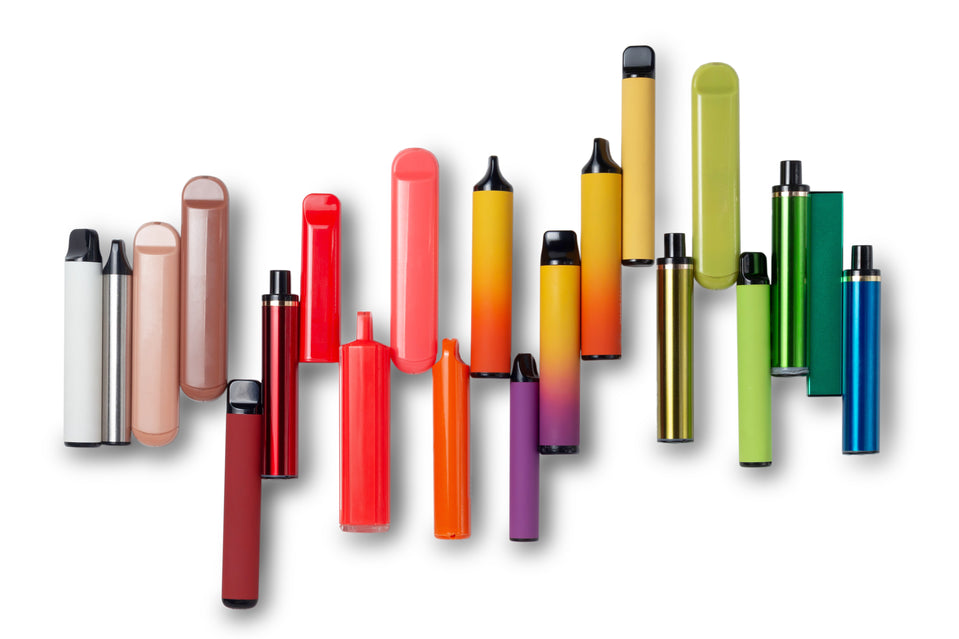Vaping crackdown Which countries are trying to ban single-use vapes amid rising health concerns

Several countries are cracking down on disposable e-cigarettes, which have become popular among teens, due to health concerns.
When e-cigarettes first came to the market, they were advertised as the lesser of two evils, helping people move away from traditional cigarettes and the health risks associated with smoking.
But in more recent years, vapes have become something of a trend among young people. The single-use vape – also known as a “puff bar” – is practically an accessory item, and an increasing number of teenagers can be seen donning the flashy stick.
Several countries around the globe are considering banning them to curb the phenomenon.
UK
In the UK, voices are increasingly calling for a ban; the most recent push has been from the Welsh government, urging the UK government to take action.
It follows a similar push from the Scottish government to get the UK government to consider a ban, citing littering of disposable e-cigarettes and the young age of puff bar consumers.
Scottish first minister Humza Yousaf called disposable vapes a “threat to both public health and the environment”.
“The World Health Organization [WHO] has said there is evidence to suggest that young people who have never smoked but use e-cigarettes, double their chance of starting to smoke tobacco cigarettes in later life”, he added.
“On the environment, the evidence is undeniable – from litter on our streets, to the risk of fires in waste facilities, there are issues which demand action”.
EU member states
Ireland is seeking people’s views ahead of a potential ban while many health and environmental associations are urging the government to act.
For example, VOICE Ireland has been very vocal on the issue, launching a petition and promoting the campaign #BanDisposableVapes on social media to make Ireland “the first country in Europe to ban disposable vape”.
Germany also intends to take action against disposable e-cigarettes. Some ecologists – including Steffi Lemke, the Green federal Minister of the Environment – have gone further, wanting to ban them from the EU altogether.
“Disposable e-cigarettes litter the environment and often end up in household waste instead of being properly disposed of as electrical appliances,” Lemke told the German newspaper Mitteldeutsche Zeitung.
“They can also cause serious problems in the disposal facilities due to fires,” she added.
Even France, the home country of all cigarette clichés, announced a vape crackdown while Belgium is awaiting the EU’s green light to prohibit them.
Sold between 8 and 12 euros at tobacconists, on websites or in supermarkets, the “puffs” trend took off at the end of 2021 promoted on social media.
Containing between 0 and 20mg/ml, disposable e-cigarettes were also criticised for leading young consumers towards regular cigarettes.
“We can be told that it is not nicotine. But it’s a reflex, a gesture that young people are getting used to. Then that’s how they go towards smoking and we have to stop that”, said French prime minister Elisabeth Borne when she announced the ban.
A ban already effective in Australia and New Zealand
New Zealand, known for its strict anti-tobacco guidelines, has had an effective ban in place since August this year.
The country has cracked down on vaping with a new set of rules to protect young people, like a lower level of nicotine, duller flavour names and an interdiction to open vape shops in the vicinity of schools, the Health Ministry has announced.
“We recognise we need to strike a balance between preventing young people from starting to vape, at the same time as having vapes available as a cessation tool for those who genuinely want to give up smoking”, said Dr Ayesha Verrall, New Zealand health minister.
The restrictions came a month after Australia announced similar measures on vaping, as the government accused the tobacco industry of trying to get the next generation of teenagers “hooked on nicotine”.
How bad are single-use vapes for health?
Invented in 2019, single-use vapes usually come with coloured packages and quickly gained popularity among teens, first in the US. The trend quickly crossed the Atlantic.
The Financial Times reported that 14 per cent of English teenagers aged between 14 and 17 years old use vapes more than once a week.
In wider Europe, the numbers are also booming with a French survey highlighting over one teen out of 10 has tried vaping.
Single-use e-cigarettes’ sweet flavours are the most compelling marketing argument for younger consumers.
According to the tobacco industry watchdog organization STOP, the combination of fruity flavours, fun packages and promotion by social media influencers are destined to target and hook a new generation of users as “replacement smokers”.
The survey highlighted that in France, 17 per cent of teens were using single-use devices, then shifted to other products.
With an increasing amount of research, it’s becoming clear that single-use vapes are far from harmless. As with electronic cigarettes, most single-use vapes contain the highly addictive nicotine.
据 Drugwatch组织报道,几乎一半的日常使用者出现了咳嗽、气短和心悸等副作用 。
尽管由于缺乏医学研究,目前尚不清楚其长期影响的程度,但一项 研究 表明,长期使用电子烟产品会严重损害人体血管功能,增加患心血管疾病的风险。





Регистрация в binance
Thank you for your sharing. I am worried that I lack creative ideas. It is your article that makes me full of hope. Thank you. But, I have a question, can you help me?
Registracija
I don’t think the title of your article matches the content lol. Just kidding, mainly because I had some doubts after reading the article.
binance h"anvisningskod
Thank you for your sharing. I am worried that I lack creative ideas. It is your article that makes me full of hope. Thank you. But, I have a question, can you help me?
Registrati
Your point of view caught my eye and was very interesting. Thanks. I have a question for you.
zoritoler imol
Thanks for the sensible critique. Me & my neighbor were just preparing to do some research about this. We got a grab a book from our local library but I think I learned more clear from this post. I am very glad to see such fantastic info being shared freely out there.
Lottery defeater
Hi there would you mind stating which blog platform you’re using? I’m going to start my own blog soon but I’m having a difficult time selecting between BlogEngine/Wordpress/B2evolution and Drupal. The reason I ask is because your design and style seems different then most blogs and I’m looking for something completely unique. P.S My apologies for getting off-topic but I had to ask!
Fitspresso
I’d perpetually want to be update on new blog posts on this web site, bookmarked! .
Pronerve6 review
This is the right blog for anyone who wants to find out about this topic. You realize so much its almost hard to argue with you (not that I actually would want…HaHa). You definitely put a new spin on a topic thats been written about for years. Great stuff, just great!
Fitpsresso
Fantastic beat ! I wish to apprentice while you amend your web site, how can i subscribe for a blog site? The account helped me a acceptable deal. I had been a little bit acquainted of this your broadcast provided bright clear idea
fitspresso
FitSpresso is a natural weight loss supplement crafted from organic ingredients, offering a safe and side effect-free solution for reducing body weight.
pinealxt
Nice blog right here! Also your web site loads up fast! What web host are you the usage of? Can I get your affiliate link on your host? I wish my site loaded up as quickly as yours lol
Prodentim
Excellent website you have here but I was wanting to know if you knew of any discussion boards that cover the same topics discussed here? I’d really love to be a part of online community where I can get responses from other experienced people that share the same interest. If you have any suggestions, please let me know. Thank you!
Neotonics reviews
I am constantly looking online for tips that can facilitate me. Thanks!
SightCare
Lovely blog! I am loving it!! Will come back again. I am bookmarking your feeds also
Kerassentials review
Very interesting topic, appreciate it for posting.
sumatra tonic
What Is Sumatra Slim Belly Tonic? Sumatra Slim Belly Tonic is a natural formula that supports healthy weight loss.
oriental blue tonic
About Blue Tonic Weight Loss Drink Recipe:The Blue Tonic Weight Loss Drink Recipe is more than just a beverage; it’s a potent blend of carefully selected ingredients designed to support your weight loss journey.
Fitspresso
I am perpetually thought about this, thanks for putting up.
Hunter Furuya
Thank you for the sensible critique. Me and my neighbor were just preparing to do some research about this. We got a grab a book from our local library but I think I learned more clear from this post. I am very glad to see such fantastic info being shared freely out there.
Leanbiome reviews
Good ?V I should certainly pronounce, impressed with your web site. I had no trouble navigating through all the tabs and related information ended up being truly easy to do to access. I recently found what I hoped for before you know it at all. Quite unusual. Is likely to appreciate it for those who add forums or something, web site theme . a tones way for your client to communicate. Excellent task..
Sugar defender drops review
Hey There. I found your blog using msn. This is a very well written article. I’ll make sure to bookmark it and come back to read more of your useful info. Thanks for the post. I will certainly return.
Lottery defeater
F*ckin¦ remarkable things here. I am very satisfied to look your post. Thanks a lot and i am having a look ahead to touch you. Will you kindly drop me a mail?
read here
You are a very smart individual!
our site
I really appreciate this post. I?¦ve been looking all over for this! Thank goodness I found it on Bing. You have made my day! Thanks again
Javaburn reviews
I must show my love for your kindness supporting those people that have the need for help on your concept. Your personal dedication to getting the message all around had been really invaluable and has frequently encouraged ladies like me to achieve their dreams. Your personal helpful advice implies much to me and even more to my fellow workers. Many thanks; from all of us.
uweed
I am glad to be a visitant of this complete web blog! , thankyou for this rare information! .
cbd
I am often to blogging and i actually admire your content. The article has actually peaks my interest. I’m going to bookmark your web site and maintain checking for brand spanking new information.
zoritoler imol
of course like your web-site however you have to test the spelling on several of your posts. Many of them are rife with spelling issues and I in finding it very bothersome to inform the reality nevertheless I will certainly come back again.
geng138
Greetings! Very helpful advice on this article! It is the little changes that make the biggest changes. Thanks a lot for sharing!
Sight Care review
I’d have to test with you here. Which is not something I usually do! I take pleasure in reading a submit that will make people think. Additionally, thanks for permitting me to comment!
hire a hacker for social media
I like what you guys are up also. Such intelligent work and reporting! Keep up the superb works guys I have incorporated you guys to my blogroll. I think it’ll improve the value of my site 🙂
Prodentim
I just could not depart your web site before suggesting that I really loved the usual info a person supply to your visitors? Is going to be back ceaselessly in order to inspect new posts.
hire a hacker uk
I’d constantly want to be update on new articles on this web site, saved to my bookmarks! .
Prodentim
Hey! I know this is kinda off topic but I was wondering which blog platform are you using for this website? I’m getting fed up of WordPress because I’ve had problems with hackers and I’m looking at options for another platform. I would be awesome if you could point me in the direction of a good platform.
Lottery Defeater
Undeniably believe that which you said. Your favorite justification seemed to be on the net the simplest thing to be aware of. I say to you, I definitely get annoyed while people consider worries that they plainly do not know about. You managed to hit the nail upon the top and defined out the whole thing without having side-effects , people can take a signal. Will probably be back to get more. Thanks
Pineal Xt
Hello my friend! I want to say that this post is awesome, great written and come with almost all significant infos. I would like to look extra posts like this .
cbd kapseln kaufen
I am now not sure the place you’re getting your info, however great topic. I needs to spend some time learning more or figuring out more. Thank you for great information I used to be looking for this info for my mission.
hire a hacker
Thanks a bunch for sharing this with all of us you actually know what you’re talking about! Bookmarked. Kindly also visit my website =). We could have a link exchange agreement between us!
Puravive
I have learn a few excellent stuff here. Certainly price bookmarking for revisiting. I surprise how much effort you put to make such a magnificent informative web site.
Sumatra Slim Belly Tonic
The other day, while I was at work, my sister stole my iphone and tested to see if it can survive a thirty foot drop, just so she can be a youtube sensation. My apple ipad is now destroyed and she has 83 views. I know this is totally off topic but I had to share it with someone!
stone packing case
I got what you mean , regards for putting up.Woh I am happy to find this website through google. “Don’t be afraid of opposition. Remember, a kite rises against not with the wind.” by Hamilton Mabie.
hire a whatsapp hacker
Some genuinely interesting points you have written.Assisted me a lot, just what I was looking for : D.
herenmode eindhoven
excellent points altogether, you just gained a brand new reader. What would you suggest in regards to your post that you made a few days ago? Any positive?
neotonics gummies reviews
I used to be recommended this website by means of my cousin. I am now not certain whether or not this post is written by means of him as no one else recognize such special about my problem. You are wonderful! Thank you!
Fitspresso
What i don’t understood is actually how you’re not really much more well-liked than you may be right now. You’re very intelligent. You realize thus considerably relating to this subject, produced me personally consider it from numerous varied angles. Its like women and men aren’t fascinated unless it is one thing to do with Lady gaga! Your own stuffs nice. Always maintain it up!
Java Burn review
Sweet blog! I found it while surfing around on Yahoo News. Do you have any suggestions on how to get listed in Yahoo News? I’ve been trying for a while but I never seem to get there! Thanks
ortopedija
Great wordpress blog here.. It’s hard to find quality writing like yours these days. I really appreciate people like you! take care
Pronerve 6
I want to point out my passion for your kind-heartedness giving support to individuals that absolutely need assistance with this important field. Your real commitment to getting the message across has been incredibly good and has continuously allowed professionals like me to achieve their dreams. Your entire warm and helpful suggestions denotes a whole lot to me and even further to my colleagues. Many thanks; from all of us.
cbd vape pen einweg kaufen
Yeah bookmaking this wasn’t a high risk determination great post! .
bonbon cbd
Howdy I am so delighted I found your blog, I really found you by error, while I was looking on Askjeeve for something else, Anyhow I am here now and would just like to say thanks a lot for a tremendous post and a all round enjoyable blog (I also love the theme/design), I don’t have time to read it all at the moment but I have saved it and also added your RSS feeds, so when I have time I will be back to read much more, Please do keep up the superb work.
Fitspresso review
Great blog here! Also your website loads up very fast! What web host are you using? Can I get your affiliate link to your host? I wish my web site loaded up as quickly as yours lol
biovanish
This design is spectacular! You certainly know how to keep a reader entertained. Between your wit and your videos, I was almost moved to start my own blog (well, almost…HaHa!) Great job. I really enjoyed what you had to say, and more than that, how you presented it. Too cool!
Dentavim reviews
Hi! I just wanted to ask if you ever have any issues with hackers? My last blog (wordpress) was hacked and I ended up losing a few months of hard work due to no backup. Do you have any solutions to prevent hackers?
hire a hacker for fund recovery
I am glad to be one of the visitants on this great website (:, regards for putting up.
hackers for hire
Lovely just what I was looking for.Thanks to the author for taking his time on this one.
Provadent
I got what you intend,saved to fav, very decent website .
Dentavim Reviews
You are a very capable individual!
Java Burn
Hello, you used to write wonderful, but the last few posts have been kinda boring?K I miss your tremendous writings. Past few posts are just a bit out of track! come on!
auckland house painters
You have brought up a very wonderful details, appreciate it for the post.
binance
Thank you for your sharing. I am worried that I lack creative ideas. It is your article that makes me full of hope. Thank you. But, I have a question, can you help me?
CBD Öle Online Kaufen
I’m still learning from you, as I’m making my way to the top as well. I definitely love reading all that is posted on your blog.Keep the stories coming. I liked it!
www.binance.com sign up
Your article helped me a lot, is there any more related content? Thanks!
creazione dell'account binance
Your point of view caught my eye and was very interesting. Thanks. I have a question for you.
Pumarehistro
Thanks for sharing. I read many of your blog posts, cool, your blog is very good.
gu10 low voltage bulbs
I actually wanted to construct a quick comment to be able to say thanks to you for all of the amazing hints you are writing at this site. My considerable internet lookup has finally been compensated with reputable strategies to share with my co-workers. I would claim that many of us readers are unquestionably lucky to dwell in a decent network with many special people with very helpful things. I feel very much lucky to have come across your web pages and look forward to really more awesome minutes reading here. Thanks once more for a lot of things.